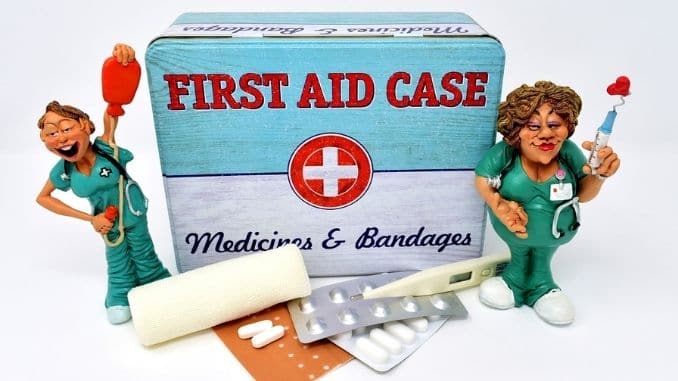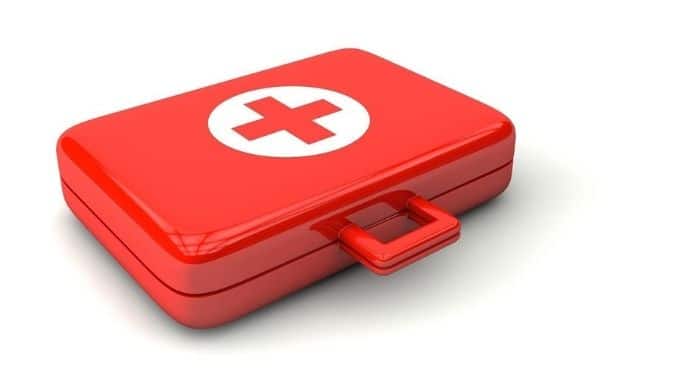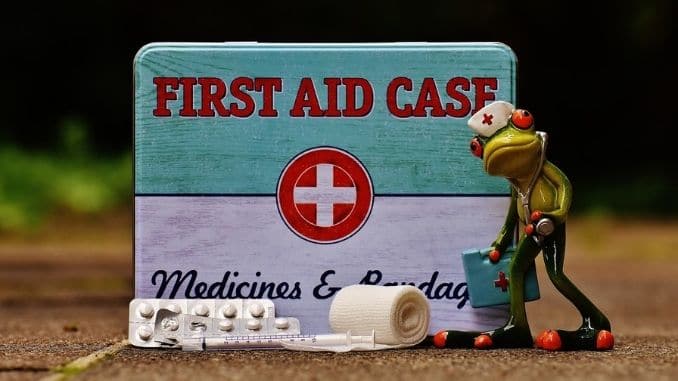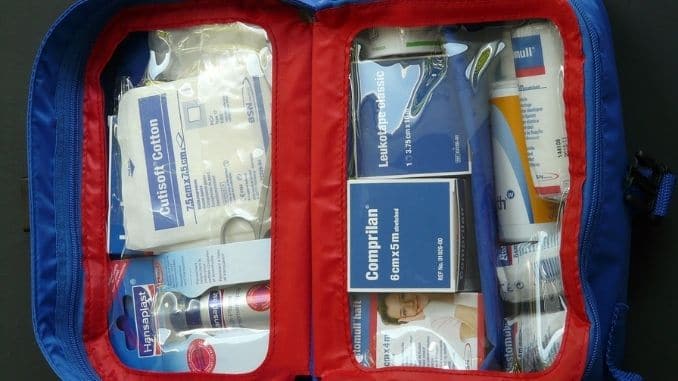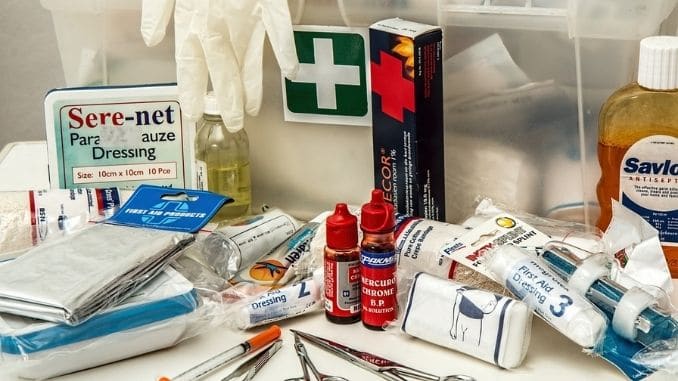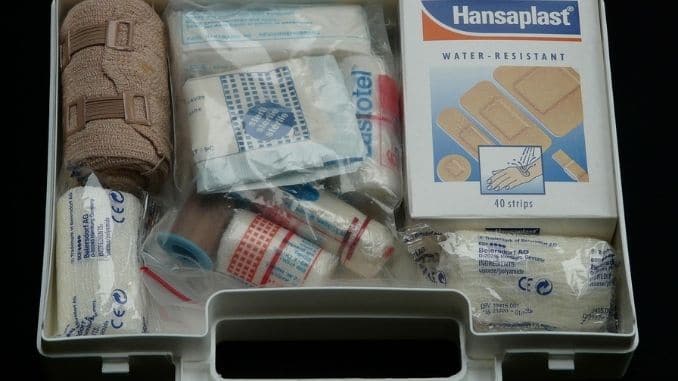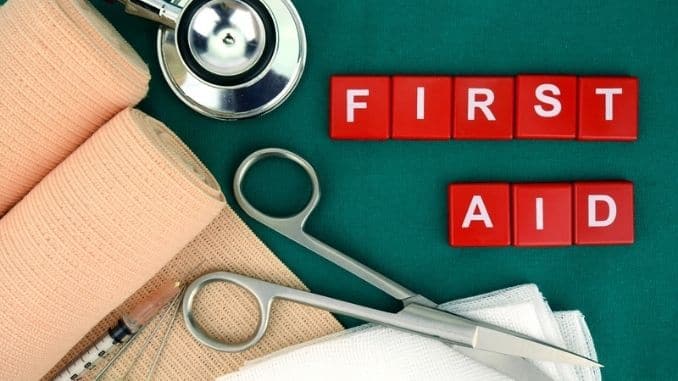
The National Safety Council (NSC) reports that in 2017, nearly 170,000 people died from unintentional injury-related deaths. Most of these occurred off the job, often when least expected, such as while on vacation, doing chores at home or driving across town.
Common injuries that can occur around the home include broken bones, cuts, scrapes, burns, trips, and falls, bruising, choking and poisoning. A well-stocked first-aid kit can help you respond quickly and effectively to most of these injuries. Prepared families should have one at home and in the car, somewhere it’s easy to get to but out of reach of young children.
If you haven’t created a first-aid kit for your family, or if you want to update yours, we have some guidelines below.
Why Is a First-aid Kit Important?
You may imagine that with today’s emergency care services, you wouldn’t need a first-aid kit, but a well-designed kit can provide a number of benefits long before emergency help arrives. It can also come in handy for those injuries that do not require emergency care but do need to be treated to prevent more serious complications.
Below are seven reasons why a good first-aid kit is a necessity for every home and vehicle.
1. Emergency Help Isn’t Always Around the Corner
Most of the time, we can call for emergency help, but it can take 10 to 30 minutes to arrive. During that time, a first-aid kit can provide the tools you need to prevent severe injuries from becoming life-threatening, or perhaps even to save someone’s life.
During natural disasters or high-level emergency times, help is even slower in arriving, so it’s best to be prepared.
2. Infections Can Take Hold Quickly
Even a small injury can become serious if it gets infected, and the damage can begin as soon as a few hours after the accident. Cleaning and disinfecting a wound quickly can prevent additional suffering down the road as well as save you money for medical care.
3. Each Person Only Has So Much Blood
Any injury involving blood loss can quickly become dangerous because when we get too low on blood, our lives hang in the balance. In a well-stocked first-aid kit, you will have tools to help stop the bleeding, which can be critical to survival.
4. Kids Often Get Hurt
If you have kids in the family, you know that accidents are bound to happen. There’s no reason to call for emergency help if the injury is minor to moderate, and you have a quality first-aid kit. Cuts, scrapes and minor burns can all be treated well at home, but without proper treatment, they can develop into more severe issues.
5. It Saves You Money
Having the tools and know-how to treat minor injuries can save you some cash in the long run. It’s a lot cheaper to clean, dress and treat a wound properly than it is to travel to a clinic and seek help there.
6. Accidents Are Scary
Anytime someone gets hurt unexpectedly, it’s a frightening experience. If you have a first-aid kit, you know right where to go and what to do, which can provide some much-needed calm to the situation.
7. Time Is Often of the Essence
Responding immediately to an injury can mean the difference between something manageable and something disastrous or even deadly. A quick response from you and your first-aid kit could save someone you care about from experiencing a much more serious outcome.
6 Items You Must Have for Your First-aid Kit
To create a quality first-aid kit, make sure you have the following items.
1. A Strong, Durable Container
First, you need something to put your supplies in. For your home-based first-aid kit, most any type of container will work. Choose from nylon bags, fanny packs, makeup cases or a clear plastic container. For kits made for the car, choose a waterproof container.
Often, a large, clear, water-resistant plastic container works best as you can see through it and everyone knows what it is. Make sure it has a zipper closure or latch-top lid. For larger kits, you can also use a duffel bag or backpack.
To separate the items for easy access, but smaller items together into labeled resealable plastic bags or buy a plastic separator, such as you may find at a craft store, to place in your box-like container.
Once you have the container, label it clearly as the “First-aid kit” so that others know what it is, then places it in an easily accessible location, but one that remains out of reach of young children.
2. Bandages
Have a wide variety of bandages to address everything from minor cuts and scrapes to larger cuts and abrasions. To get started, make sure you have:
- 25 adhesive bandages of various sizes
- 5 to 10 sterile gauze pads of various sizes
- A roll of cloth adhesive tape
- At least 2 roller bandages (ace bandages) of varying sizes
- 5 to 10 larger bandages of varying shapes
- Blister bandages or treatments (like moleskin)
- Butterfly closures
3. Basic Tools
Certain tools form the basis of the first-aid kit and are what you’ll use when treating injuries. Some good options include:
- Tweezers
- Thermometer
- Cotton balls and swabs
- Small, sharp scissors
- Hand sanitizer
- Antiseptic cleansing wipes
- Resealable plastic bags (for disposing of medical waste)
- Nonlatex gloves
- CPR breathing barrier mask
- Small mirror
- Razorblade or knife
- Aluminum finger splint
- Safety pins
- Disposable instant cold packs
- Alcohol wipes
- Flashlight and extra batteries
- A blanket
- Bee sting kit
- Tick remover
- Turkey baster (for flushing out wounds)
- Large pair of toenail clippers
4. Medications and Ointments
Make a separate section or separate bag for these so that they are found easily and check the expiration dates regularly:
- Antibiotic ointment
- Antiseptic solution (like hydrogen peroxide)
- Hydrocortisone cream
- Acetaminophen, ibuprofen, and aspirin
- Calamine lotion
- Cream or spray to relieve insect bites and stings or plain baking soda
- Aloe vera gel
- Antacid tablets
- Rehydration salts
- Antidiarrheal pills
- Any necessary prescription medications (if traveling)
- Burn gel packets
- Allergy medications (like antihistamines or EpiPen)
- Sterile eyewash saline
- Nasal decongestant
- Laxatives
5. Travel Necessities
When building kits to take in the car or when traveling, make sure you have these extra items.
Any medications anyone needs:
- Waterproof matches
- Solar or crank charger for phones
- Sunscreen
- Insect repellant
- Whistle
- Duct tape
- Sewing needle and thread
- Water purification tablets
- Small notebook and waterproof writing instrument
- Tourniquet
- Old cell phone (you don’t need a current contract with a service provider to call 911; all you need is enough battery power to turn the phone on)
6. Documentation
For both at-home and travel kits, add these documents to ensure you have the information you need:
- First-aid instruction booklet
- List of important phone numbers, including those for your doctor, pediatrician, poison control, local emergency services, emergency road service providers, friends who can help and other emergency numbers
- A list of required medications for each person
- Medical consent and history forms for each family member (particularly when traveling)
Keep Your Kit Updated
Once you have your kit completed, don’t put it away and forget about it. The kit will need your regular attention and updates. Medicines can expire, containers can leak and, if something goes bad before you need it, you could end up in an emergency very quickly.
Pencil in time about every two to three months to go through your kit and make sure everything is up to speed. Restock those items that have been depleted and replace those that have expired or malfunctioned. Update your list of required medications and phone numbers as well, if necessary.
You may also find it helpful to create a list of everything that’s in your kit once you complete it, so when it comes time to restock, you can see exactly what you need and what you don’t easily.
What About Buying a Ready-made Kit?
If you want to save yourself some trouble, you can purchase a ready-made kit. It can be difficult to find quality kits at reasonable prices, but they can at least get you started. Purchase one you can afford and then add to it with the other items you need.
Home improvement, outdoor and pharmaceutical stores are usually the best place to get started. Some good options include Home Depot, REI, Dick’s Sporting Goods, Sportsman’s Warehouse, CVS, Walgreens, Target and Walmart. You can also find many first-aid kits available online. Just be sure to check all the items inside before purchasing to make sure they are the quality that you want.
First-aid Training
To be completely prepared for an emergency, it’s best to get some first-aid training. Building a first-aid kit is only the first step. If you don’t know how to use it, you could freeze up in an emergency, allowing panic to take over.
There are various classes you can take advantage of. Check with the following organizations:
- Local community college
- Local CPR classes
- Local hospitals
- The American Red Cross
- National Safety Council
- Online resources, including the American Academy of CPR and First Aid, Inc.
For the best foods that slim and heal your body, make sure to check out The Best Foods that Rapidly Slim & Heal in 7 Days, here!
.

